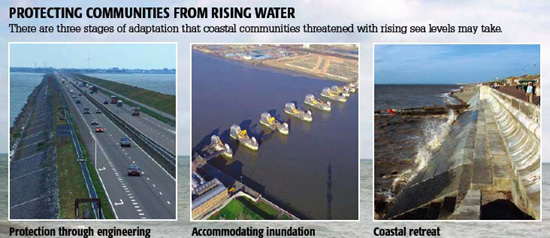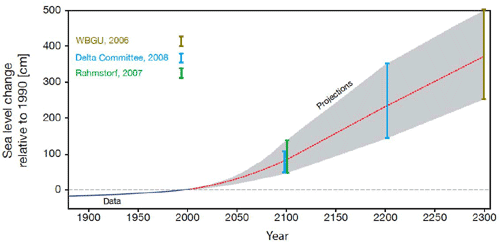There are various potential measures we might consider taking in defending our coastlines against the threat of sea level rise. We might think of them as sequential steps that can be taken as rising sea level continues to encroach on coastal settlements. We are likely already committed to at least 0.3 m (i.e., roughly 1 foot) of global sea level rise, enough, as we've seen previously, to threaten increased coastal erosion along the east and gulf coast of the U.S., and to submerge low-lying island regions.

© 2015 Pearson Education, Inc.
The first step is to actively confront encroaching seas by building structures such as polders, which reclaim inundated coastal regions, and coastal defenses such as dikes, beach nourishments, etc., which provide an impediment to rising waters. The United States Navy is considering walls to protect assets at the Washington Naval Yard and the U.S. Naval Academy.
When that is no longer adequate, one might move on to the next step — accommodating some degree of inundation. That might include building flood-proof structures, and floating platforms for agriculture, etc. The final step is retreat. It can involve managed retreating, such as the building of sea walls, and planned evacuation when no other options are available. The island nation of Tuvalu, threatened with imminent impacts from sea level rise, for example, has already arranged for retreat to New Zealand when necessary.
Let us perform a thought experiment. Recall the projected sea level rise for the next two centuries (see figure below). Let us consider the gray region to represent the region of 95% confidence. Suppose you are an owner of a coastal property in a location where sea level rise is predicted to follow the projected global mean rise. Suppose that at 0.3 m sea level rise you can expect significant erosion of your beachfront, at 0.5 m of sea level rise you can expect regular flooding of your property from coastal storms, and at 1 m of sea level rise you can expect the front stairs to your house to be below sea level.
Think About It!
Come up with an answer to this question:
What actions would you take, and when would you plan to take them?Click to reveal an answer.
One reasonable response would be that at 0.3 m some engineering solution, such as beach nourishment, might be viable, while at 0.5 m some degree of accommodation (e.g., using stilts to raise the house above the beach) might be possible, and at 1 m retreat, i.e., requesting some sort of bail out from FEMA, might be your only recourse.
As for the timeline of response, that would depend on how risk averse you are. If you were to err on the highly cautious side, you might be guided by the upper end of the range of projected sea level rise, which gives 0.3 m at about 2050, 0.5 m at about 2070, and 1 m around 2080. That means you would be planning on minor engineering measures in less than 4 decades, while your children who inherit the property would be engaged in major engineering measures in less than 6 decades, and then bailing out by the turn of the century.

